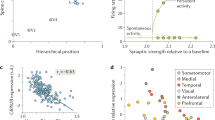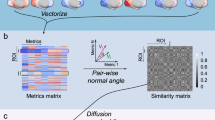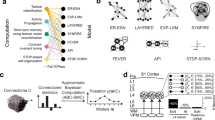Abstract
Uncovering structural regularities and architectural topologies of cortical circuitry is vital for understanding neural computations. Recently, an experimentally constrained algorithm generated a dense network reconstruction of a ∼0.3-mm3 volume from juvenile rat somatosensory neocortex, comprising ∼31,000 cells and ∼36 million synapses. Using this reconstruction, we found a small-world topology with an average of 2.5 synapses separating any two cells and multiple cell-type-specific wiring features. Amounts of excitatory and inhibitory innervations varied across cells, yet pyramidal neurons maintained relatively constant excitation/inhibition ratios. The circuit contained highly connected hub neurons belonging to a small subset of cell types and forming an interconnected cell-type-specific rich club. Certain three-neuron motifs were overrepresented, matching recent experimental results. Cell-type-specific network properties were even more striking when synaptic strength and sign were considered in generating a functional topology. Our systematic approach enables interpretation of microconnectomics 'big data' and provides several experimentally testable predictions.
This is a preview of subscription content, access via your institution
Access options
Access Nature and 54 other Nature Portfolio journals
Get Nature+, our best-value online-access subscription
$29.99 / 30 days
cancel any time
Subscribe to this journal
Receive 12 print issues and online access
$209.00 per year
only $17.42 per issue
Buy this article
- Purchase on Springer Link
- Instant access to full article PDF
Prices may be subject to local taxes which are calculated during checkout







Similar content being viewed by others
Change history
14 June 2017
In the version of this article initially published online, the number of neurons for layer 6 was given in Figure 1a as 1,2715 instead of 12,715, the single asterisks in the left panels of Figure 4b and Figure 4c should have been double asterisks, and "left" and "right" were reversed in the legend to Figure 4c. The errors have been corrected in the print, PDF and HTML versions of this article.
References
Sporns, O., Tononi, G. & Kötter, R. The human connectome: a structural description of the human brain. PLoS Comput. Biol. 1, e42 (2005).
Seung, H.S. Reading the book of memory: sparse sampling versus dense mapping of connectomes. Neuron 62, 17–29 (2009).
Fornito, A., Zalesky, A. & Breakspear, M. The connectomics of brain disorders. Nat. Rev. Neurosci. 16, 159–172 (2015).
Varshney, L.R., Chen, B.L., Paniagua, E., Hall, D.H. & Chklovskii, D.B. Structural properties of the Caenorhabditis elegans neuronal network. PLoS Comput. Biol. 7, e1001066 (2011).
Briggman, K.L., Helmstaedter, M. & Denk, W. Wiring specificity in the direction-selectivity circuit of the retina. Nature 471, 183–188 (2011).
Chklovskii, D.B., Vitaladevuni, S. & Scheffer, L.K. Semi-automated reconstruction of neural circuits using electron microscopy. Curr. Opin. Neurobiol. 20, 667–675 (2010).
Kasthuri, N. et al. Saturated reconstruction of a volume of neocortex. Cell 162, 648–661 (2015).
Helmstaedter, M. et al. Connectomic reconstruction of the inner plexiform layer in the mouse retina. Nature 500, 168–174 (2013).
White, J.G., Southgate, E., Thomson, J.N. & Brenner, S. The structure of the nervous system of the nematode Caenorhabditis elegans. Phil. Trans. R. Soc. Lond. B 314, 1–340 (1986).
Thomson, A.M. & Lamy, C. Functional maps of neocortical local circuitry. Front. Neurosci. 1, 19–42 (2007).
Barbour, D.L. & Callaway, E.M. Excitatory local connections of superficial neurons in rat auditory cortex. J. Neurosci. 28, 11174–11185 (2008).
Lefort, S., Tomm, C., Floyd Sarria, J.C. & Petersen, C.C. The excitatory neuronal network of the C2 barrel column in mouse primary somatosensory cortex. Neuron 61, 301–316 (2009).
Pfeffer, C.K., Xue, M., He, M., Huang, Z.J. & Scanziani, M. Inhibition of inhibition in visual cortex: the logic of connections between molecularly distinct interneurons. Nat. Neurosci. 16, 1068–1076 (2013).
Song, S., Sjöström, P.J., Reigl, M., Nelson, S. & Chklovskii, D.B. Highly nonrandom features of synaptic connectivity in local cortical circuits. PLoS Biol. 3, e68 (2005).
Silberberg, G. & Markram, H. Disynaptic inhibition between neocortical pyramidal cells mediated by Martinotti cells. Neuron 53, 735–746 (2007).
Perin, R., Berger, T.K. & Markram, H. A synaptic organizing principle for cortical neuronal groups. Proc. Natl. Acad. Sci. USA 108, 5419–5424 (2011).
Egger, R., Dercksen, V.J., Udvary, D., Hege, H.-C. & Oberlaender, M. Generation of dense statistical connectomes from sparse morphological data. Front. Neuroanat. 8, 129 (2014).
Markram, H. et al. Reconstruction and simulation of neocortical microcircuitry. Cell 163, 456–492 (2015).
Stepanyants, A., Martinez, L.M., Ferecskó, A.S. & Kisvárday, Z.F. The fractions of short- and long-range connections in the visual cortex. Proc. Natl. Acad. Sci. USA 106, 3555–3560 (2009).
Xue, M., Atallah, B.V. & Scanziani, M. Equalizing excitation-inhibition ratios across visual cortical neurons. Nature 511, 596–600 (2014).
Barabasi, A.L. & Albert, R. Emergence of scaling in random networks. Science 286, 509–512 (1999).
Amaral, L.A., Scala, A., Barthelemy, M. & Stanley, H.E. Classes of small-world networks. Proc. Natl. Acad. Sci. USA 97, 11149–11152 (2000).
Clauset, A., Shalizi, C.R. & Newman, M.E.J. Power-law distributions in empirical data. SIAM Rev. Soc. Ind. Appl. Math. 51, 661–703 (2009).
Colizza, V., Flammini, A., Serrano, M.A. & Vespignani, A. Detecting rich-club ordering in complex networks. Nat. Phys. 2, 110–115 (2006).
Bonifazi, P. et al. GABAergic hub neurons orchestrate synchrony in developing hippocampal networks. Science 326, 1419–1424 (2009).
van den Heuvel, M.P. & Sporns, O. Rich-club organization of the human connectome. J. Neurosci. 31, 15775–15786 (2011).
Nigam, S. et al. Rich-club organization in effective connectivity among cortical neurons. J. Neurosci. 36, 670–684 (2016).
Towlson, E.K., Vértes, P.E., Ahnert, S.E., Schafer, W.R. & Bullmore, E.T. The rich club of the C. elegans neuronal connectome. J. Neurosci. 33, 6380–6387 (2013).
van den Heuvel, M.P., Bullmore, E.T. & Sporns, O. Comparative connectomics. Trends Cogn. Sci. 20, 345–361 (2016).
Milo, R. et al. Network motifs: simple building blocks of complex networks. Science 298, 824–827 (2002).
Rieubland, S., Roth, A. & Häusser, M. Structured connectivity in cerebellar inhibitory networks. Neuron 81, 913–929 (2014).
Watts, D.J. & Strogatz, S.H. Collective dynamics of 'small-world' networks. Nature 393, 440–442 (1998).
Rubinov, M. & Sporns, O. Complex network measures of brain connectivity: uses and interpretations. Neuroimage 52, 1059–1069 (2010).
Fagiolo, G. Clustering in complex directed networks. Phys. Rev. E 76, 026107 (2007).
Bettencourt, L.M., Stephens, G.J., Ham, M.I. & Gross, G.W. Functional structure of cortical neuronal networks grown in vitro. Phys. Rev. E 75, 021915 (2007).
Yu, S., Huang, D., Singer, W. & Nikolic, D. A small world of neuronal synchrony. Cereb. Cortex 18, 2891–2901 (2008).
London, M., Roth, A., Beeren, L., Häusser, M. & Latham, P.E. Sensitivity to perturbations in vivo implies high noise and suggests rate coding in cortex. Nature 466, 123–127 (2010).
Newman, M.E.J. The structure and function of complex networks. SIAM Rev. Soc. Ind. Appl. Math. 45, 167–256 (2003).
Landau, I.D., Egger, R., Dercksen, V.J., Oberlaender, M. & Sompolinsky, H. The impact of structural heterogeneity on excitation-inhibition balance in cortical networks. Neuron 92, 1106–1121 (2016).
Roxin, A. The role of degree distribution in shaping the dynamics in networks of sparsely connected spiking neurons. Front. Comput. Neurosci. 5, 8 (2011).
Lago-Fernández, L.F., Huerta, R., Corbacho, F. & Sigüenza, J.A. Fast response and temporal coherent oscillations in small-world networks. Phys. Rev. Lett. 84, 2758–2761 (2000).
Barthélemy, M. Spatial networks. Phys. Rep. 499, 1–101 (2011).
Atkinson, S.E. & Williams, S.R. Postnatal development of dendritic synaptic integration in rat neocortical pyramidal neurons. J. Neurophysiol. 102, 735–751 (2009).
Lorenzon, N.M. & Foehring, R.C. The ontogeny of repetitive firing and its modulation by norepinephrine in rat neocortical neurons. Brain Res. Dev. Brain Res. 73, 213–223 (1993).
Larkman, A.U. Dendritic morphology of pyramidal neurones of the visual cortex of the rat: I. Branching patterns. J. Comp. Neurol. 306, 307–319 (1991).
Romand, S., Wang, Y., Toledo-Rodriguez, M. & Markram, H. Morphological development of thick-tufted layer v pyramidal cells in the rat somatosensory cortex. Front. Neuroanat. 5, 5 (2011).
Baker, S.T. et al. Developmental changes in brain network hub connectivity in late adolescence. J. Neurosci. 35, 9078–9087 (2015).
Kopelowitz, E., Abeles, M., Cohen, D. & Kanter, I. Sensitivity of global network dynamics to local parameters versus motif structure in a cortexlike neuronal model. Phys. Rev. E 85, 051902 (2012).
Bassett, D.S. & Sporns, O. Network neuroscience. Nat. Neurosci. 20, 353–364 (2017).
Schröter, M., Paulsen, O. & Bullmore, E.T. Micro-connectomics: probing the organization of neuronal networks at the cellular scale. Nat. Rev. Neurosci. 18, 131–146 (2017).
Reimann, M.W., King, J.G., Muller, E.B., Ramaswamy, S. & Markram, H. An algorithm to predict the connectome of neural microcircuits. Front. Comput. Neurosci. 9, 120 (2015).
Ramaswamy, S. et al. The neocortical microcircuit collaboration portal: a resource for rat somatosensory cortex. Front. Neural Circuits 9, 44 (2015).
Erdős, P. & Rényi, A. On random graphs I. Publicationes Mathematicae (Debrecen) 6, 290–297 (1959).
Alstott, J., Bullmore, E. & Plenz, D. Powerlaw: a Python package for analysis of heavy-tailed distributions. PLoS One 9, e85777 (2014).
Newman, M.E., Strogatz, S.H. & Watts, D.J. Random graphs with arbitrary degree distributions and their applications. Phys. Rev. E 64, 026118 (2001).
Milo, R. et al. Superfamilies of evolved and designed networks. Science 303, 1538–1542 (2004).
Acknowledgements
We thank the members of the Segev Lab for helpful discussions related to this project. We also thank I. Nadav for the image processing. This work was supported by the Gatsby Charitable Foundation and the EPFL-Hebrew University Collaborative Grant, the EPFL support to the Laboratory of Neural Microcircuitry (LNMC), the ETH Domain for the Blue Brain Project (BBP), the Human Brain Project through the European Union Seventh Framework Program (FP7/2007-2013) under grant agreement no. 604102 (HBP) and from the European Union H2020 FET program through grant agreement no. 720270 (HBP SGA1), the Brain Science grant of the Sachs Family and by the ISF Centers of Excellence grants 1789/11 and 2180/15.
Author information
Authors and Affiliations
Contributions
E.G. and I.S. conceived the study and wrote the manuscript. E.G. carried out the analysis. M.L. helped in developing the functional small-world analysis. A.G. and M.L. participated in discussions. S.R., M.W.R., E.M. and H.M. developed the in silico microcircuit and provided the respective data.
Corresponding authors
Ethics declarations
Competing interests
The authors declare no competing financial interests.
Integrated supplementary information
Supplementary Figure 1 Morphological cell types (m-types)
2D projection of m-types, obtained by overlaying multiple reconstructed morphologies, aligning somata to a single point, and summing the fiber length per μm3 (axon left, green; dendrite right, magenta). Density plots for 55 known inhibitory (cyan) and excitatory (red) m-types arranged horizontally by layer. Morphologies in L2 and L3 are not separated. Inhibitory neurons: DAC, Descending Axon Cell; LAC, Large Axon Cell; HAC, Horizontal Axon Cell; NGC-DA, Neurogliaform Cell with Dense Axonal arborization; NGC-SA, Neurogliaform Cell with Slender Axonal arborization; SAC, Small Axon Cell; BP, Bipolar Cell; BTC, Bitufted Cell; ChC, Chandelier Cell; DBC, Double Bouquet Cell; LBC, Large Basket Cell; MC, Martinotti Cell; NBC, Nest Basket Cell; NGC, Neurogliaform Cell; SBC, Small Basket Cell. Excitatory neurons: PC, Pyramidal Cell; SP & SS, Star Pyramidal and Spiny Stellate cells; TTPC1 & TTPC2, late (1) and early (2) bifurcating apical tufts; UTPC & STPC, Untufted and Slender-tufted; TPC, Tufted Pyramidal Cells; dendrites terminating in L4 (TPC-L4) and L1 (TPC-L1), UTPC, Untufted Pyramidal Cells; IPC, Pyramidal Cell with inverted apical-like dendrites; BPC, Pyramidal Cell with Bipolar apical-like dendrites. Inset, expanded L5-TTPC1 with an exemplar reconstruction superimposed.
Supplementary Figure 2 The probability of finding a connection between two neurons decays with their intersomatic distance
The probability is computed for each distance bin (50 bins were used for the whole distance domain 0 - 2,090 μm) by dividing the number of observed connections in this bin (inset) by the number of existing pairs in the bin. I-to-I (blue) connections are more confined than E-to-E (red). Black depicts the distance dependence profile of the entire microcircuit.
Supplementary Figure 3 Correcting for the boundary effect on degree distributions
Both (a) in-degrees and (b) out-degrees of neurons in the central NMC show dependency on their distance from the center of the column (denoted by the crosses at left NMC images). Images at left depict 2D histograms of degrees across the horizontal plane of the column (322 bins). (c) and (d), when taking into account the external connections from (c) and to (d) the surrounding columns, the distance dependence of the neuron’s degrees disappears. Pearson correlations coefficients, r, and their respective P-values are depicted.
Supplementary Figure 4 Existence of hub neurons
(a) In-degrees and (b) out-degrees show long tail distributions also when accounting for extrinsic connections from/to external neurons (gray lines depict internal degree distribution, as in Figure 3). (c) The top 157 (half-percentile) highly connected in-hubs (having 1313-1444 incoming connections) arise from only 4 cell types (pie chart). The top 157 highly connected out-hubs (having 1321-1467 outgoing connections) arise primarily from 3 cell-types. The tendency of intermediate and deep layers to possess in-hubs, whereas out-hubs tend to emerge from superficial and intermediate layers is depicted. (d,e) Highly connected hubs as in (c) but in terms of the number of contacts and synaptic conductance, respectively.
Supplementary Figure 5 Small-world organization with respect to ER random networks
Entire network and E/I subnetworks, both at the network-wide level and within layers demonstrate: (a) A characteristic path length, l, that is comparable to that expected from the corresponding ER-random networks l(ER). (b) Clustering coefficient, c higher than expected from the corresponding random networks c(ER).
Supplementary Figure 6 Rich club analysis using two implementations for generating random networks with matching degree sequence
The open squares are as in Fig. 3i whereas the orange dots are computed using the algorithm provided in the Brain Connectivity Toolbox33. The ratio of the number of connections among NMC neurons whose total degree (in-degree + out-degree) > d to that expected from random networks with matching degree sequence (namely, each node maintained in-degree and out-degree similar to its original values) is plotted for all d (N=1,000, s.d. is depicted by gray). This ratio is above 1 for high degree neurons, reflecting the presence of rich-club phenomenon according both implementations.
Supplementary information
Supplementary Text and Figures
Supplementary Figures 1–6 and Supplementary Tables 1–3. (PDF 1067 kb)
Supplementary Software
Supplementary Software. (ZIP 16 kb)
Rights and permissions
About this article
Cite this article
Gal, E., London, M., Globerson, A. et al. Rich cell-type-specific network topology in neocortical microcircuitry. Nat Neurosci 20, 1004–1013 (2017). https://doi.org/10.1038/nn.4576
Received:
Accepted:
Published:
Issue Date:
DOI: https://doi.org/10.1038/nn.4576
This article is cited by
-
Synchronization of delayed coupled neurons with multiple synaptic connections
Cognitive Neurodynamics (2024)
-
Single-neuron analysis of dendrites and axons reveals the network organization in mouse prefrontal cortex
Nature Neuroscience (2023)
-
Alteration of a brain network with stable and strong functional connections in subjects with schizophrenia
Schizophrenia (2022)
-
Aberrant maturation and connectivity of prefrontal cortex in schizophrenia—contribution of NMDA receptor development and hypofunction
Molecular Psychiatry (2022)
-
The effects of the general anesthetic sevoflurane on neurotransmission: an experimental and computational study
Scientific Reports (2021)



